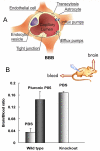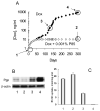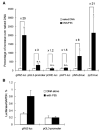Pluronic block copolymers: evolution of drug delivery concept from inert nanocarriers to biological response modifiers
- PMID: 18534704
- PMCID: PMC2678942
- DOI: 10.1016/j.jconrel.2008.04.013
Pluronic block copolymers: evolution of drug delivery concept from inert nanocarriers to biological response modifiers
Abstract
Polymer nanomaterials have sparked a considerable interest as vehicles used for diagnostic and therapeutic agents; research in nanomedicine has not only become a frontier movement but is also a revolutionizing drug delivery field. A common approach for building a drug delivery system is to incorporate the drug within the nanocarrier that results in increased solubility, metabolic stability, and improved circulation time. With this foundation, nanoparticles with stealth properties that can circumvent RES and other clearance and defense mechanisms are the most promising. However, recent developments indicate that select polymer nanomaterials can implement more than only inert carrier functions by being biological response modifiers. One representative of such materials is Pluronic block copolymers that cause various functional alterations in cells. The key attribute for the biological activity of Pluronics is their ability to incorporate into membranes followed by subsequent translocation into the cells and affecting various cellular functions, such as mitochondrial respiration, ATP synthesis, activity of drug efflux transporters, apoptotic signal transduction, and gene expression. As a result, Pluronics cause drastic sensitization of MDR tumors to various anticancer agents, enhance drug transport across the blood brain and intestinal barriers, and causes transcriptional activation of gene expression both in vitro and in vivo. Collectively, these studies suggest that Pluronics have a broad spectrum of biological response modifying activities which make it one of the most potent drug targeting systems available, resulting in a remarkable impact on the emergent field of nanomedicine.
Figures









References
-
- Kabanov AV, Vinogradov SV, Suzdaltseva YG, Alakhov V. Water-soluble block polycations as carriers for oligonucleotide delivery. Bioconjug Chem. 1995;6:639–643. - PubMed
-
- Savic R, Luo L, Eisenberg A, Maysinger D. Micellar nanocontainers distribute to defined cytoplasmic organelles. Science. 2003;300:615–618. - PubMed
-
- Kwon GS. Polymeric micelles for delivery of poorly water-soluble compounds. Crit Rev Ther Drug Carrier Syst. 2003;20:357–403. - PubMed
-
- Trentin D, Hubbell J, Hall H. Non-viral gene delivery for local and controlled DNA release. J Control Release. 2005;102:263–275. - PubMed
Publication types
MeSH terms
Substances
Grants and funding
LinkOut - more resources
Full Text Sources
Other Literature Sources
Research Materials

